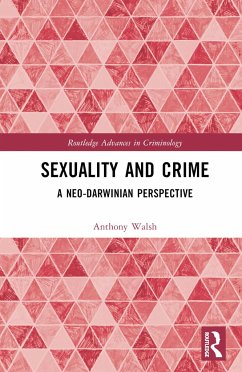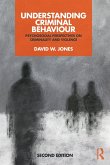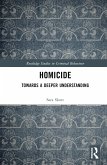- Gebundenes Buch
- Merkliste
- Auf die Merkliste
- Bewerten Bewerten
- Teilen
- Produkt teilen
- Produkterinnerung
- Produkterinnerung
This work explores the tight relationship between criminality and indiscriminate sexuality within the framework of life history theory.
Andere Kunden interessierten sich auch für
![Culture, Diversity, and Criminal Justice Culture, Diversity, and Criminal Justice]() Culture, Diversity, and Criminal Justice175,99 €
Culture, Diversity, and Criminal Justice175,99 €![Biosocial Criminology Biosocial Criminology]() Biosocial Criminology204,99 €
Biosocial Criminology204,99 €![The Routledge International Handbook of Biosocial Criminology The Routledge International Handbook of Biosocial Criminology]() The Routledge International Handbook of Biosocial Criminology286,99 €
The Routledge International Handbook of Biosocial Criminology286,99 €![Understanding Criminal Behaviour Understanding Criminal Behaviour]() David W JonesUnderstanding Criminal Behaviour184,99 €
David W JonesUnderstanding Criminal Behaviour184,99 €![Homicide Homicide]() Sara SkottHomicide184,99 €
Sara SkottHomicide184,99 €![Victims and Memory After Terrorism Victims and Memory After Terrorism]() Ana Milo¿evi¿Victims and Memory After Terrorism184,99 €
Ana Milo¿evi¿Victims and Memory After Terrorism184,99 €![An Introduction to Criminal Psychology An Introduction to Criminal Psychology]() Russil DurrantAn Introduction to Criminal Psychology225,99 €
Russil DurrantAn Introduction to Criminal Psychology225,99 €-
-
-
This work explores the tight relationship between criminality and indiscriminate sexuality within the framework of life history theory.
Hinweis: Dieser Artikel kann nur an eine deutsche Lieferadresse ausgeliefert werden.
Hinweis: Dieser Artikel kann nur an eine deutsche Lieferadresse ausgeliefert werden.
Produktdetails
- Produktdetails
- Verlag: Routledge
- Seitenzahl: 136
- Erscheinungstermin: 16. Juni 2023
- Englisch
- Abmessung: 235mm x 157mm x 12mm
- Gewicht: 361g
- ISBN-13: 9781032503172
- ISBN-10: 1032503173
- Artikelnr.: 67515375
- Verlag: Routledge
- Seitenzahl: 136
- Erscheinungstermin: 16. Juni 2023
- Englisch
- Abmessung: 235mm x 157mm x 12mm
- Gewicht: 361g
- ISBN-13: 9781032503172
- ISBN-10: 1032503173
- Artikelnr.: 67515375
Anthony Walsh is a professor of criminal justice at Boise State University. He has taught biosocial criminology, statistics, and philosophy of law there for 34 years. He received his PhD in criminology from Bowling Green State University in 1983. He worked as a marine, merchant seaman, police officer, and probation officer before entering academia at the age of 44. He is widely published, with 50 books and 150 articles and book chapters on a variety of topics including criminology and biosocial aspects of crime. He was awarded lifetime achievement awards from both the Biosocial Criminology Association and the Biopsychosocial Section of the American Society of Criminology for his research in biosocial criminology. His work has been featured on the Phil Donahue Show, Nova, and Nippon (Japanese) TV.
Chapter One: Bringing Biology Back In
Introduction
Biosocial Criminology
The Fallacy of Genetic Determinism
Behavior and Tinbergen's Four Questions
Chapter Two: Behavioral Genetics: Genes and Heritability
From Gene to Protein
The Concept of Heritability
Twin and Adoption Studies
Heritability in Different Environments
Shared and Non-Shared Environment
Gene-Environment Interaction and Gene-Environment Correlation
Chapter Three: Molecular Genetics and Behavior
Genetic Polymorphisms
Quantitative Trait Loci
Epigenetics
Dopaminergic Polymorphisms and Criminal and Sexual Behavior
Genetics and Human Freedom
Chapter Four: How Criminal Traits Evolve and Are Retained
Crime is Normal
Altruism
Empathy
Cooperation Creates Niches for Cheats
Detecting and Punishing Cheats
Chapter Five: Evolutionary Theories of Crime
Evolutionary Theories of Crime: Past is Prolog
Cheater and Conditional Adaptation Theories
The Gender Ratio Issue
The Age-Crime Curve
Chapter Six: Life History Theory and the Covariance of Sexual and Criminal
Traits
The Basics of Life History Theory
Human Life Histories and the K-Factor
Linking Sexuality to Criminal Traits and Behaviors
The Role of the Environment on Life History Strategies
Chapter Seven: The Human Brain
The Enchanted Loom and Reinforcement Sensitivity Theory
Wiring the Brain: Experience Expected and Experience Dependent Mechanisms
Synaptogenesis as Neural Darwinism
Neurotransmitters
The Serotonergic System
Norepinephrine and Epinephrine
Testosterone and Cortisol
Chapter Eight: The Antisocial Personalities: Psychopaths and Sociopaths
Differentiating Antisocial Personality Disorder, Psychopathy, and
Sociopathy
The Psychopathy Checklist-Revised
Evolutionary Considerations
The Neurobiology of Psychopathy
Neurochemistry Associated with Psychopathy
Sociopathy
Chapter Nine: The Sex Ratio, Fast Life Histories, and Crime
The Sex Ratio
Crime and the Sex Ratio
The Sex Ratio in the African American Community
The Sex Ratio, Illegitimacy, and Poverty
High Sex Ratios and Crime
References
Introduction
Biosocial Criminology
The Fallacy of Genetic Determinism
Behavior and Tinbergen's Four Questions
Chapter Two: Behavioral Genetics: Genes and Heritability
From Gene to Protein
The Concept of Heritability
Twin and Adoption Studies
Heritability in Different Environments
Shared and Non-Shared Environment
Gene-Environment Interaction and Gene-Environment Correlation
Chapter Three: Molecular Genetics and Behavior
Genetic Polymorphisms
Quantitative Trait Loci
Epigenetics
Dopaminergic Polymorphisms and Criminal and Sexual Behavior
Genetics and Human Freedom
Chapter Four: How Criminal Traits Evolve and Are Retained
Crime is Normal
Altruism
Empathy
Cooperation Creates Niches for Cheats
Detecting and Punishing Cheats
Chapter Five: Evolutionary Theories of Crime
Evolutionary Theories of Crime: Past is Prolog
Cheater and Conditional Adaptation Theories
The Gender Ratio Issue
The Age-Crime Curve
Chapter Six: Life History Theory and the Covariance of Sexual and Criminal
Traits
The Basics of Life History Theory
Human Life Histories and the K-Factor
Linking Sexuality to Criminal Traits and Behaviors
The Role of the Environment on Life History Strategies
Chapter Seven: The Human Brain
The Enchanted Loom and Reinforcement Sensitivity Theory
Wiring the Brain: Experience Expected and Experience Dependent Mechanisms
Synaptogenesis as Neural Darwinism
Neurotransmitters
The Serotonergic System
Norepinephrine and Epinephrine
Testosterone and Cortisol
Chapter Eight: The Antisocial Personalities: Psychopaths and Sociopaths
Differentiating Antisocial Personality Disorder, Psychopathy, and
Sociopathy
The Psychopathy Checklist-Revised
Evolutionary Considerations
The Neurobiology of Psychopathy
Neurochemistry Associated with Psychopathy
Sociopathy
Chapter Nine: The Sex Ratio, Fast Life Histories, and Crime
The Sex Ratio
Crime and the Sex Ratio
The Sex Ratio in the African American Community
The Sex Ratio, Illegitimacy, and Poverty
High Sex Ratios and Crime
References
Chapter One: Bringing Biology Back In
Introduction
Biosocial Criminology
The Fallacy of Genetic Determinism
Behavior and Tinbergen's Four Questions
Chapter Two: Behavioral Genetics: Genes and Heritability
From Gene to Protein
The Concept of Heritability
Twin and Adoption Studies
Heritability in Different Environments
Shared and Non-Shared Environment
Gene-Environment Interaction and Gene-Environment Correlation
Chapter Three: Molecular Genetics and Behavior
Genetic Polymorphisms
Quantitative Trait Loci
Epigenetics
Dopaminergic Polymorphisms and Criminal and Sexual Behavior
Genetics and Human Freedom
Chapter Four: How Criminal Traits Evolve and Are Retained
Crime is Normal
Altruism
Empathy
Cooperation Creates Niches for Cheats
Detecting and Punishing Cheats
Chapter Five: Evolutionary Theories of Crime
Evolutionary Theories of Crime: Past is Prolog
Cheater and Conditional Adaptation Theories
The Gender Ratio Issue
The Age-Crime Curve
Chapter Six: Life History Theory and the Covariance of Sexual and Criminal
Traits
The Basics of Life History Theory
Human Life Histories and the K-Factor
Linking Sexuality to Criminal Traits and Behaviors
The Role of the Environment on Life History Strategies
Chapter Seven: The Human Brain
The Enchanted Loom and Reinforcement Sensitivity Theory
Wiring the Brain: Experience Expected and Experience Dependent Mechanisms
Synaptogenesis as Neural Darwinism
Neurotransmitters
The Serotonergic System
Norepinephrine and Epinephrine
Testosterone and Cortisol
Chapter Eight: The Antisocial Personalities: Psychopaths and Sociopaths
Differentiating Antisocial Personality Disorder, Psychopathy, and
Sociopathy
The Psychopathy Checklist-Revised
Evolutionary Considerations
The Neurobiology of Psychopathy
Neurochemistry Associated with Psychopathy
Sociopathy
Chapter Nine: The Sex Ratio, Fast Life Histories, and Crime
The Sex Ratio
Crime and the Sex Ratio
The Sex Ratio in the African American Community
The Sex Ratio, Illegitimacy, and Poverty
High Sex Ratios and Crime
References
Introduction
Biosocial Criminology
The Fallacy of Genetic Determinism
Behavior and Tinbergen's Four Questions
Chapter Two: Behavioral Genetics: Genes and Heritability
From Gene to Protein
The Concept of Heritability
Twin and Adoption Studies
Heritability in Different Environments
Shared and Non-Shared Environment
Gene-Environment Interaction and Gene-Environment Correlation
Chapter Three: Molecular Genetics and Behavior
Genetic Polymorphisms
Quantitative Trait Loci
Epigenetics
Dopaminergic Polymorphisms and Criminal and Sexual Behavior
Genetics and Human Freedom
Chapter Four: How Criminal Traits Evolve and Are Retained
Crime is Normal
Altruism
Empathy
Cooperation Creates Niches for Cheats
Detecting and Punishing Cheats
Chapter Five: Evolutionary Theories of Crime
Evolutionary Theories of Crime: Past is Prolog
Cheater and Conditional Adaptation Theories
The Gender Ratio Issue
The Age-Crime Curve
Chapter Six: Life History Theory and the Covariance of Sexual and Criminal
Traits
The Basics of Life History Theory
Human Life Histories and the K-Factor
Linking Sexuality to Criminal Traits and Behaviors
The Role of the Environment on Life History Strategies
Chapter Seven: The Human Brain
The Enchanted Loom and Reinforcement Sensitivity Theory
Wiring the Brain: Experience Expected and Experience Dependent Mechanisms
Synaptogenesis as Neural Darwinism
Neurotransmitters
The Serotonergic System
Norepinephrine and Epinephrine
Testosterone and Cortisol
Chapter Eight: The Antisocial Personalities: Psychopaths and Sociopaths
Differentiating Antisocial Personality Disorder, Psychopathy, and
Sociopathy
The Psychopathy Checklist-Revised
Evolutionary Considerations
The Neurobiology of Psychopathy
Neurochemistry Associated with Psychopathy
Sociopathy
Chapter Nine: The Sex Ratio, Fast Life Histories, and Crime
The Sex Ratio
Crime and the Sex Ratio
The Sex Ratio in the African American Community
The Sex Ratio, Illegitimacy, and Poverty
High Sex Ratios and Crime
References







